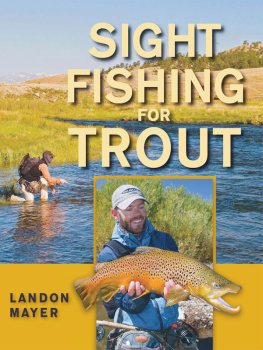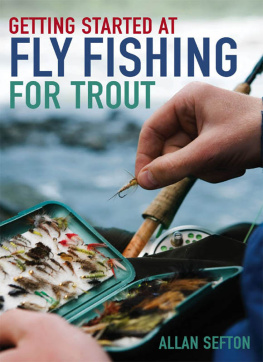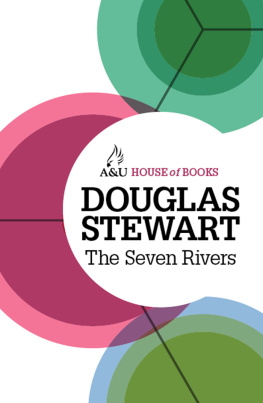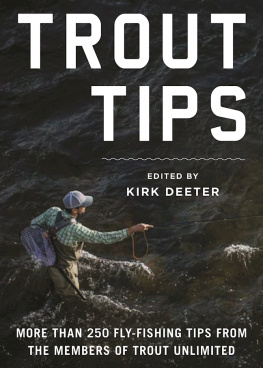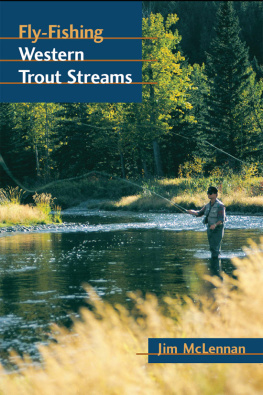FLY FISHING
The Way of a Trout With a Fly

PLATE I.THE BLUE DUN.
As rendered in ten different schools.
FLY FISHING
The Way of a Trout With a Fly
G. E. M. SKUES
DOVER PUBLICATIONS, INC.
Mineola, New York
Bibliographical Note
This Dover edition, first published in 2017, is an unabridged republication of the work originally published by A. & C. Black, Ltd., London, in 1921 under the title The Way of a Trout with a Fly. Two color plates from the original publication appear in black and white in this Dover edition.
Library of Congress Cataloging-in-Publication Data
Names: Skues, G. E. M. (George Edward Mackenzie)
Title: Fly fishing : the way of a trout with a fly / G. E. M. Skues.
Other titles: Way of a trout with a fly
Description: Dover edition. | Mineola, New York : Dover Publications, Inc., 2017. | Originally published under the title: The Way of a Trout with a Fly (London : A. & C. Black, Ltd., 1921).
Identifiers: LCCN 2016044705| ISBN 9780486814629 | ISBN 0486814629
Subjects: LCSH: Trout fishing. | Flies, Artificial.
Classification: LCC SH687 .S45 2017 | DDC 799.12dc23 LC record available at https://lccn.loc.gov/2016044705
Manufactured in the United States by LSC Communications
814629012017
www.doverpublications.com
DEDICATED
TO
THE FLY-FISHERS CLUB
IN GRATITUDE FOR MANY HAPPY HOURS
AND SOME PRICELESS FRIENDS
Myself when young did eagerly frequent
Doctor and Saint and heard great Argument
About it and about, but evermore
Came out by the same door wherein I went.
RUBAIYAT OF OMAR KHAYYM.
THE WAY OF A TROUT WITH A FLY
WHEN the Wise Man laid it down that there were three things which were too wonderful for himyea, four which he knew nothe came to the climax with the way of a man with a maid. Some future Solomon will end with a fifththe way of a trout with a flyfor it combines the poise of the eagle in the air, the swift certainty of a serpent upon a rock, and the mystery of the way of a ship in the midst of the sea, with the incalculableness of the way of a man with a maid. Our aviators seem to be on their way towards a solution of the way of the eagle in the air. The mystery of the way of a ship in the midst of the sea has yielded all its secrets to the persistence of modern man, but the way of a man with a maid and the way of a trout with a fly remain with us to be a delight and a torment to thousands of generations yet unborn.
FOREWORD
AUTHORITIES darken counsel. An authority is a person engaged in the invidious business of stereotyping and disseminating information, frequently incorrect. Angling literature teems with examples. I imagine that few anglers have devoted more time than I have to the study of authorities. From Dame Juliana to the latest issue of the press there is scarcely a book on trout-fly dressing and trout fishing which I have not studied and analyzed, and this conclusion seems to me inevitable. It was not until I realized this that my reading became any use to me. Up to that point I had been swallowing wholesale, with my facts, all sorts of fallacies and inaccuracies, alike in the matter of dressings and their use, and what they were intended to represent. From that point on an author became merely a suggester of experiment a means of testing and checking my own observations by the water side, and no longer a small god to be believed in and trusted as infallible. And that is all an author, writing on any progressive art or science, ought to be. It is good now and again to have the ideas and discoveries of an epoch analyzed in the crucible of some acute intellect, and the problem restated, but this age has put an end to all belief in finality, and the business of that analysis should be to clear away the lumber of the past, while preserving all that is of value, and not to add more than can be helped to the lumber that some later writer will striveprobably in vainto clear away. An authority who lays down a law and dogmatizes is a narcotic, a soporific, a stupefier, an opiate. The true function of an authority is to stimulate, not to paralyze, original thinking. But then, I suppose, he wouldnt be an authority.
Since the very beginning of things men have talked fish and fishing, just as they have talked religion and metaphysics, without progress commensurate with the amount of labour and energy expended, and with as many divergencies to right and left and as much slipping back and floundering in morasses of error. That the subject is so eternally interesting is my only excuse for the collection of the speculations contained in the ensuing pages. That they advance the sum of human knowledge on the subjects with which they deal is too much to hope.
For more years than I care to look back upon it has been my ambition to write a work upon trout-fly dressing, and it was my desire that it should exceed in scope all previous books on the art, and should examine and elucidate the methods of all the schools of dressing which this country has produced. But I was determined not to rush hastily into print before experience had sufficiently ripened my knowledge to give me assurance that my deductions were sound. I read omnivorously all that had been written on the subject, and the more I read the more I became impressed with the conviction that to make any advance upon the past it would be necessary to discard much of the learning of the past, to go back to the beginning, and to think out and rediscover the principles upon which the practice of the art should be based.
It is a singular fact that among the many works which have dealt with the subject of trout-fly dressing, it is impossible to find one which deals at once practically and comprehensively with the theory of the art. Cutcliffes Trout-fly Fishing on Rapid Streams, one of the most intelligent works on fly fishing ever written, explores a corner of the subject, but his patterns are mainly lures, and when he comes to deal with patterns which are, or purport to be, imitations, representations or suggestions of the natural fly, he is manifestly out of his depth.
It therefore became my plan to attempt a work on the theory of the art of trout-fly dressing, with enough of the practice to illustrate the various points made and the methods of the various schools. I would give much to be able to leave behind me, when I pass over the ferry, a work which would extricate the subject from the confusion in which generations of inaccurate observation and loose thinking and writing have involved it.
It was an ambitious project, but that would not have deterred me from the attempt; and I only gave up the project when I reached the conclusion that there is one governing factor in the treatment of the subject upon which I know nothing, and upon whichso far as I can learnthe scientific knowledge of my age is unable to help me. I refer to the vision of the trout. As those who penetrate beyond the opening pages of this volume will discover, there are, in my opinion, reasons for suspecting that the eyesight of the trout differs from that of man in its appreciation both of form and of colour. In what these differences consist, if they existand I do not pretend that the evidence of their existence is conclusiveI am entirely ignorant, and I see no means of lightening my darkness any more than, as a being of three dimensions, I see any prospect of appreciating the secrets of the fourth dimension. If I could understand these differences, and if, understanding them, I could put them into simple, lucid English, comprehensible to fly dressers of every class, then I could have given this generation a work on a subject never yet comprehensively treated in any language, which would at any rate have registered an advance in the art, and would have done something to elevate it out of the rut of convention, aggravated by empiricism, in which the practitioners of the ages down to this have toiled. It was not, however, to be, and I have arrived at a time of life when I have little hope that the advance of science will have solved the questions I would pose to it, while I still have the energy to undertake such a work as I have indicated. In these circumstances I have no wish to add yet one more to those primers on trout-fly dressing, accepted by a too credulous public as authoritative and for the time being final, of which the literature of angling with the fly is full. To do so would be but to add to confusion already more than sufficiently confounded.


